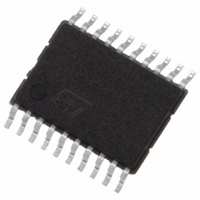STPM11ATR STMicroelectronics, STPM11ATR Datasheet - Page 23

STPM11ATR
Manufacturer Part Number
STPM11ATR
Description
IC ENERGY METER 1 PHASE 20TSSOP
Manufacturer
STMicroelectronics
Datasheet
1.STPM13ATR.pdf
(46 pages)
Specifications of STPM11ATR
Input Impedance
100 KOhm
Measurement Error
0.1%
Voltage - I/o High
1.5V
Voltage - I/o Low
0.8V
Current - Supply
4.7mA
Voltage - Supply
3 V ~ 5.5 V
Operating Temperature
-40°C ~ 85°C
Mounting Type
Surface Mount
Package / Case
20-TSSOP
Meter Type
Single Phase
Output Voltage
+/- 0.4 V
Output Current
150 mA
Input Voltage
3 V to 5.5 V
Operating Temperature Range
- 40 C to + 85 C
Mounting Style
SMD/SMT
Lead Free Status / RoHS Status
Lead free / RoHS Compliant
Other names
497-5984-2
STPM11, STPM12, STPM13, STPM14
7.10
7.11
When internal signals are not good enough to perform the computation, i.e. line period is out
or range or ∑Δ signals from the analog part are stacked at high or low logic level, or no load
condition is activated, the tamper module is disabled and its state is preset to normal.
Phase compensation
The STPM1X is does not introduce any phase shift between voltage and current channels.
However, the voltage and current signals come from transducers, which could have inherent
phase errors. For example, a phase error of 0.1° to 0.3° is not uncommon for a current
transformer (CT). These phase errors can vary from part to part, and they must be corrected
in order to perform accurate power calculations. The errors associated with phase mismatch
are particularly noticeable at low power factors. The STPM1x provide a means of digitally
calibrating these small phase errors through a introducing delays on the voltage or current
signal. The amount of phase compensation can be set using the 4 bits of the phase
calibration register (CPH).
The default value of this register is at a value of 0 which gives 0° phase compensation. A
CPH value of 15 (1111) introduces a phase compensation of +0.576°. This compensates
the phase shift usually introduced by the current sensor, while the voltage sensor, normally
a resistor divider, does not introduce any delay. The resolution step of the phase
compensation is 0.038°.
Clock generator
All the internal timing of the STPM1X is based on the CLKOUT signal. This signal is
generated by different circuits according to the STPM1x version.
●
●
The clock generator is powered from analog supply and is responsible for two tasks. The
first one is to retard the turn-on of some function blocks after POR in order to help smooth
start of external power supply circuitry by keeping all major loads off.
The second task of the clock generator is to provide all necessary clocks for analog and
digital parts. Within this task, the MDIV configuration bit is used to inform the device about
the nominal frequency value of CLKOUT. The suggested operation frequency range is from
4.000 MHz to 4.194 MHz.
STPM11/13: Internal RC Oscillator. A resistor connected between CLKIN and Ground
will set the RC current. For 4 MHz operation the suggested settling resistor is 12 kΩ;
The oscillator frequency can be compensated using the CRC configuration bit (see
Table 15
STPM12/14: Quartz Oscillator. The oscillator circuit is designed to support an external
crystal. The suggested circuit is depicted in
external oscillator signal source that must be connected to the CLKOUT pin.
and
Figure
14)
Doc ID 13167 Rev 7
Figure
18. These versions support also an
Theory of operation
23/46












